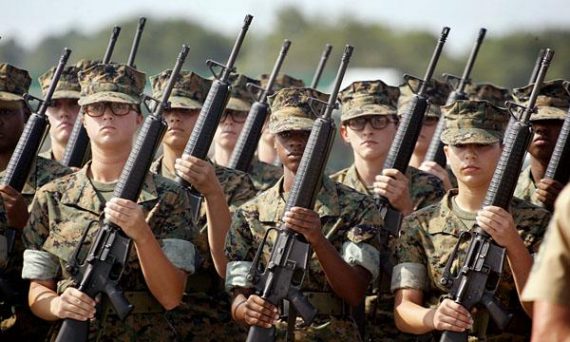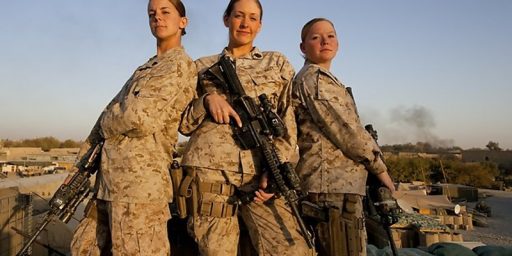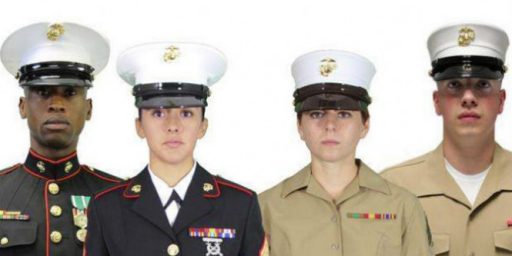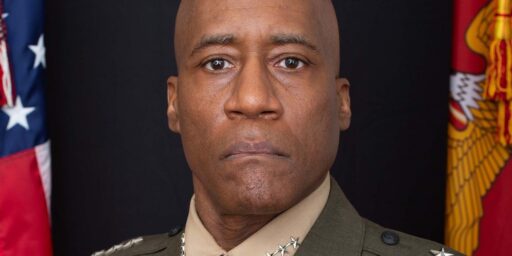Four Women Complete Marine Infantry Training; Marines Deem Pullups Too Dangerous for Women
The juxtaposition of two stories in the Marine Times strikes me as odd.
The juxtaposition of two stories in the Marine Times strikes me as odd.
“Source: 4 female Marines will graduate enlisted infantry training this week“:
Four women will graduate this week from the Marine Corps’ enlisted infantry training course, Marine Corps Times has learned.
Their successful completion of the program, confirmed Monday by a Marine official with knowledge of ongoing efforts to determine what additional ground combat jobs should open to women, is a historic milestone, one that would suggest at least some female Marines posses both the physical strength and acumen to keep pace with their male counterparts on the battlefield. A graduation ceremony is scheduled for Thursday at Camp Geiger, N.C.
The four women are assigned to Delta Company, Infantry Training Battalion, which is part of the Marine Corps’ School of Infantry-East. Fifteen women began the 59-day course Sept. 24. By Oct. 28. the beginning of the grueling 12½-mile march — what many consider the course’s most strenuous event — there were seven women remaining, along with 246 men.. It’s not immediately clear how many men passed the course.
Throughout the training, female students were held to the same standards as men, Marine officials said. For example, during the 12½-mile march, all students were required to haul almost 90-pounds of combat gear. The women assigned to Delta Company also were required to perform pull-ups — not a flexed-arm hang — during their Physical Fitness Test.
The women who graduate from infantry training on Thursday will not be assigned to infantry units, nor will they earn an infantry occupational specialty. They will report to their originally slated schoolhouses to earn a non-combat MOS.
Since last year, new female lieutenants have been invited to attend the Corps’ Infantry Officer Course at Marine Corps Base Quantico, Va.. To date, however, none has passed.
Whether this is an indicator that Marines hold their infantry officers to higher standards, than enlisted Marines are more capable, or simply the law of large numbers is hard to assess from the small sample. Nor is it obvious what policy conclusion to draw from the fact that some small number of women can make it through infantry training. Regardless, completing this demanding training to standard is an impressive achievement for these four young Marines.
It’s odd, then, to have this announcement come out the same day–indeed, within the same hour:
“Corps postpones pullups for women, cites potential risks“:
Female Marines will now have more time to prepare for the pullup requirement to pass the Physical Fitness Test.
The Corps announced Friday that Phase 1 of the change requiring female Marines to complete pullups as part of the Physical Fitness Test, in which women were given the option of doing pullups or the flexed-arm hang, “will continue into calendar year 2014.” Service officials want to further evaluate and validate the assumption that pullups are an appropriate metric for assessing upper-body strength in all Marines, said Lt. Col. Neil Murphy, a Marine spokesman at the Pentagon.
“Data collected does indicate some potential risks with executing a complete transition at this time to a [pullup]-only PFT for female Marines,” he said. “… Further assessment is expected to last into [calendar year 2014]. However, a final timetable has not been established.”
Phase 2, which would end the era of the flexed-arm hang, was set to begin on Jan. 1. When it does take effect, women will be required to complete three pullups to pass the PFT, the same number required of men. In order to attain a perfect score, women will need to complete eight pullups.
The number of young women who can train their bodies to execute three pull-ups is geometrically higher than the number that can make it through infantry training. And, certainly, pull-ups are an excellent metric for assessing upper body strength; that’s never been the question. Rather, given that women were historically excluded from the military occupational specialities that most required upper body strength, the leadership decided that women should be judged according to a different metric. But, given that male Marines are held to the three pull-up standard regardless of MOS, it’s hard to conceive of an argument for continuing to hold women to a lower standard in a Corps that allows women to serve in all fields.






Isn’t it possible that there are better exercises to determine strength than the pullup though? It’s not bad, but maybe there are better ways to measure things. Doesn’t automatically mean it will be a lower standard, maybe just a more accurate/useful one. Until a new test comes out and rationale for it, seems premature to fret over ‘lowering standards’ unless you’re pushing a theme separate from the current facts.
P.S. what “risks” are you having with a pull-up? It’s a body-weight exercise. If you can’t pull yourself up, you can’t. The only risk I can think of is yanking yourself up so quickly you hit your head on the bar.
I can’t believe it only takes three pull-ups for male marines to pass the PFT.
Sorry for my ignorance, are all these tests done at the same time? Because just doing three pull-ups is not much of a standard by itself, not even for the supposedly weaker sex. I can do several more than that, and I’m in my 40s, slightly overweight, and rarely do any strength training. I’m not trying to brag; I’m just pointing out this shouldn’t be difficult or dangerous for any young adult that is anywhere close to being Marine calibre.
“Since last year, new female lieutenants have been invited to attend the Corps’ Infantry Officer Course at Marine Corps Base Quantico, Va.. To date, however, none has passed.Whether this is an indicator that Marines hold their infantry officers to higher standards, than enlisted Marines are more capable, or simply the law of large numbers is hard to assess from the small sample.”
This comment is an indicator of the author’s ignorance. As a retired Marine Infantry Officer, not only have I been through the Marine Corps’ Infantry Officer’s Course, I also served as a company commander at the School of Infantry, where enlisted Marines receive their infantry training. In order to set a positive example I participated in all of the training exercises that my enlisted students were expected to perform. Therefore, I can comment intelligently on this subject. The Marine Corps has a much higher standard for it’s officers than for it’s junior enlisted members, and infantry officers must meet a higher standard still, within tge officer community. As a leader
, it is not enough to be able to understand the skills and tactics of infantry combat, one must be able to lead and set a positive example in horrific conditions, which requires a high level of physical and mental endurance. The institution established to create such leaders, the Infantry Officers Course, is understandably strenuous, much more so than its enlisted counterpart. Not only must students become experts in infantry warfare, they are pushed to their limits, because an officer who quits in training will almost certainly fail in combat.
i can do 20 an dim in the best shape of my life!!?? what is the risk? im confused
Greetings:
What was that that Gomer Pyle, USMC used to say, “Surprise, surprise, surprise!” ???
Me, I’m surprised they all didn’t get trophies.
@Cameron: As a former Army officer, I get that officers are and should be held to higher standards. But these are Marine officers who have already passed the requirements for commissioning and graduated The Basic School. There’s no physiological reason that they shouldn’t be up to the mental challenges of Infantry training. So, the question is whether the physical standards for officer infantry training are significantly higher than the physical standards for enlisted infantry training.
Maybe it’s just my opinion, but I honestly believe that the “risk” they are speaking of is not a physical danger to Women Marines. I believe that the only “risk” was that the trial period showed that the percentage of PFT failures was going to increase dramatically if Women Marines were required to do pull-ups instead of the flexed-arm hang. Yes, there are some Women Marines who are more than capable of doing three pull-ups. But pull-ups are indeed an excellent measure of the upper body strength of a person, and upper body strength is of paramount importance in combat.
@Rafer Janders:
The three pull ups is a minimum requirement. If a male Marine does only the minimum in all three events (pull-ups, ab crunches and three mile run) he will fail the PFT.
@Cameron:
“…an officer who quits in training will almost certainly fail in combat.”
Truer words were never spoken. The only thing that can be added is that when the officer fails in combat, good soldiers and Marines will die as a result.
I got up to about 20 when I was in school. I also had a bar at home back then. I can do about 8 or 9 now, but if I got another bar, I could eventually get back up there. Bars are not cheap, but the home improvement stores have the supplies to make your own cheaper. I don’t use those kind that clamp over the doors or in the door jam.
@James Joyner:
Sir,
I was an enlisted Marine grunt, and can say that the physical standards of the School of Infantry are very low when compared to what we did in the operating forces. The longest hump in SOI is 12 miles, with no crew served weapons (for the 0311s), and it it is at a fairly slow pace. Again, this is compared to humps in the FMF. We had too many Marines report to us out of SOI that fell out of 5 mile range hikes because SOI does not condition them for the real thing.
The Basic School is a requirement for all Marine Officers before they go to their MOS school. Infantry Officer Course is designed to train infantry officers only (obviously). IOC is far more difficult than anything they face in TBS.
The short answer is, yes, entry level requirements are much higher for infantry officers than enlisted grunts, as they should be. That said, training in the Fleet units is far more difficult than anything we faced in entry level schools (SOI at least, won’t speak for IOC).
@robb:
The standards are to pass the PFT (3 pull ups, crunches, and a 3 mile run), a knowledge test on basic infantry stuff, and a 12 mile hike. None of the tests are that difficult (more than 90% of males graduate all the time). Once the new grunts report to their Fleet unit, and that’s where the real training begins (humps go out to 25 miles, with about 60-70 pounds MORE than what they carried in basic infantry training if they are a weapons MOS, at a much faster pace).
man up, end of story. demi moore isn’t starring in this real life adventure- pull your weight or get out of the way.
@grumpy realist: @Cameron:
Give me a seasoned NCO above Sgt to follow any day. Butter bars hang pictures of the actor John Wayne next to their Phys Ed degree and are mostly concerned about grooming their next Fit Rep at the O club.
When I was in Desert Storm there was one latrine for men and another “nice” one with seats for the Women in our desert camp. The men’s always had a line and the WM’s was always empty. A fellow enlisted and I decided to use the available women’s outhouse after dark. It was a three seater side by side. Satisfied we had outsmarted everyone in the line as we enjoyed luxurious facilities we were surprised when the door swung open and someone sat down next to us. We just kept quiet, then the only woman in the camp, a Major asked us what unit us girls were from. My buddy did his best “Gotta go” pretending to be a girl as we both jumped up and ran into the dark. She was screaming for the guard and a man hunt began looking for the two men who had been in the women’s latrine. To us as enlisted Marines it was funny, to her she had been violated. Its a rough game and best to keep them in support roles.
@robb: There is no better indicator of upper body strength than the pullup. If women want to be taken seriously as a part of a combat team, they must be held to the same physical fitness standards that men are held. There is no room for political correctness on the battlefield.
@James Joyner:
Yes. Physical standards are tougher in infantry officer training than in enlisted training.
@Robert:
That’s certainly the general opinion in combat sports like judo, wrestling and MMA. The only other ones you hear mentioned are the benchpress (not nearly as useful unless your sport is power lifting), and overhead press (with various dangers involved for those who don’t have proper form).
I find it hard to believe that any fit and healthy person, male or female, has trouble doing 3 pullups. Its a very low standard, even for old guys like me, and I don’t think its a barrier for women – I see young women at the gym doing pullups all the time. I’ve never counted how many, but easily more than 3.
@george: You wouldn’t believe the few numbers that can not even do one – in middle and high school. Strength exercises have been thrown out in most pe classes, replaced by “creative movement” (you make up your own exercises), the latest “fad” in education. After all, someone might get hurt or too tired doing some strength exercises.
@Tyrell:
Okay, that’s a scary thought.
Fits in with the study showing a significant number of kids are slower runners than their parents were though.
http://www.bbc.co.uk/news/health-24998497
@george: Remember it’s harder for women to develop muscles because of our lack of testosterone. Unless women start all-over body-building at a young age, you’re more likely to get a woman who has no strength, period (worries about being over-weight) or someone like me–I did ballet for 10 years, which means I have the kick of a mule and little upper body strength.
I would think that women who were athletic during middle school and high school are more likely to have the upper body strength, but am still scratching my head as to what sport would develop the upper body enough. The only one I can think of is swimming.
@grumpy realist:
I know there’s generally a significant difference in strength between men and women (I do a number of martial arts, including judo and wrestling, where there are separate male and female divisions for just this reason). However my observation – mainly but not completely based on years of training/coaching – is that fit young women (presumably the ones interested in enlisting belong to this category) can typically do 3 pullups (and fit young males should be able to do in the high teens low twenties).
Its not that women have to develop the same upper body strength, but the standard of three pullups shouldn’t be a hurdle. Interestingly enough, I remember seeing that the record for one-arm chinups was by a woman in the past (haven’t glanced at the Guiness book for years, don’t know if it still is).
Off the top of my head, common sports that develop upper body strength would including the various grappling sports, gymnastics, rugby, the field events in track and field … and actually gymnastics would be a great thing to train every child in, boy or girl, until they reach high school, for many reasons. I’m not so sure about swimming – the swimmers I’ve known are very fit, but none struck me as being particularly strong, at least compared to some other sports.
Ballet is great for a lot of things, but I can see how it might not help much for upper body strength. But from what I’ve seen of modern dance, it takes at least some upper body strength for women – seems to have a fair amount of lifting or holding partners, pushup type moves etc.
But I’ll add the caveate that the girls and boys who go into things like wrestling and judo might be stronger than average to begin with, so maybe my sample size is biased. High school gym had separate boys/girls classes, so I don’t know how many (if any) pullups the girls did. I doubt there were any boys who couldn’t do at least ten, and some got into the thirties (the smaller, wirey ones with not much weight to pull).